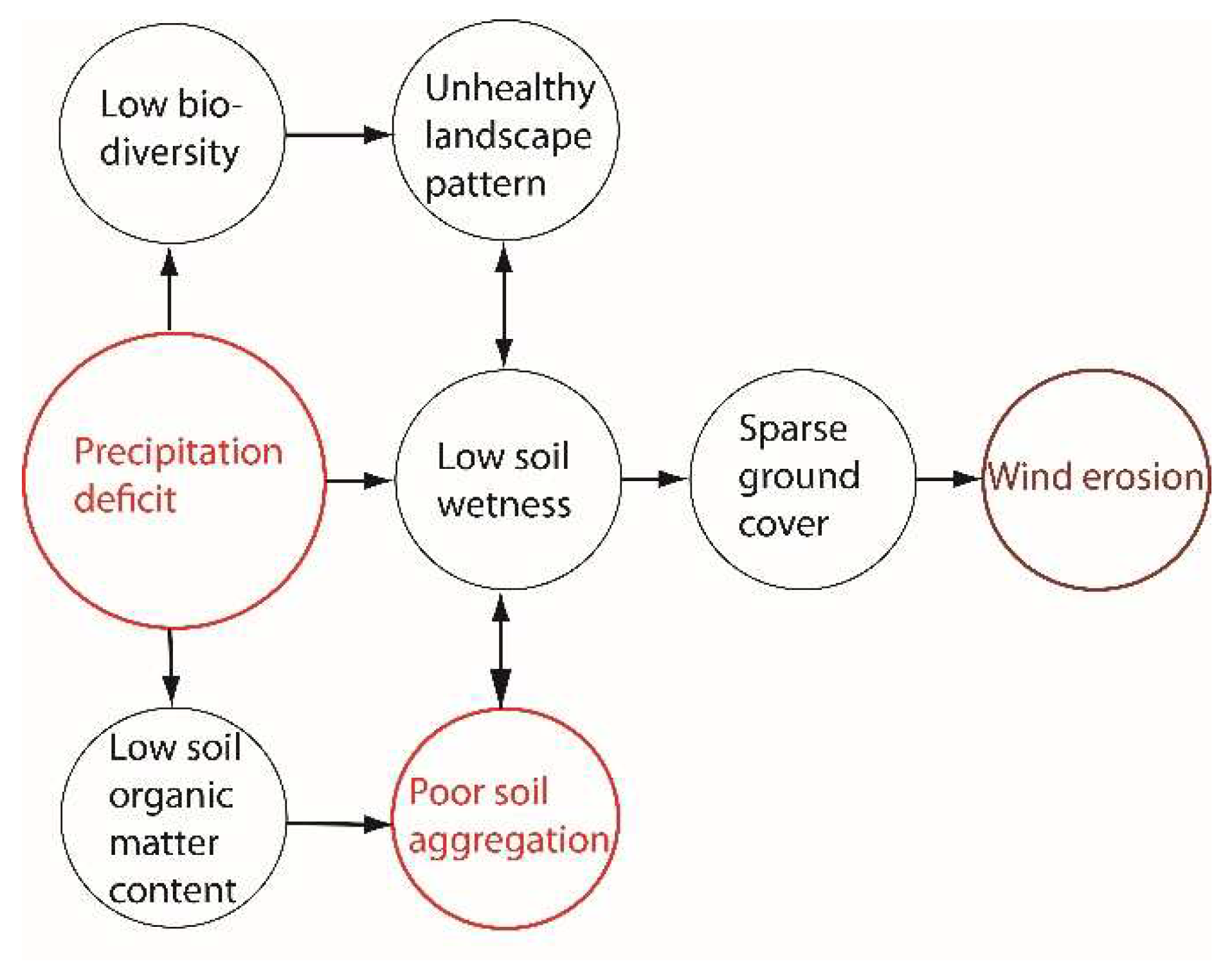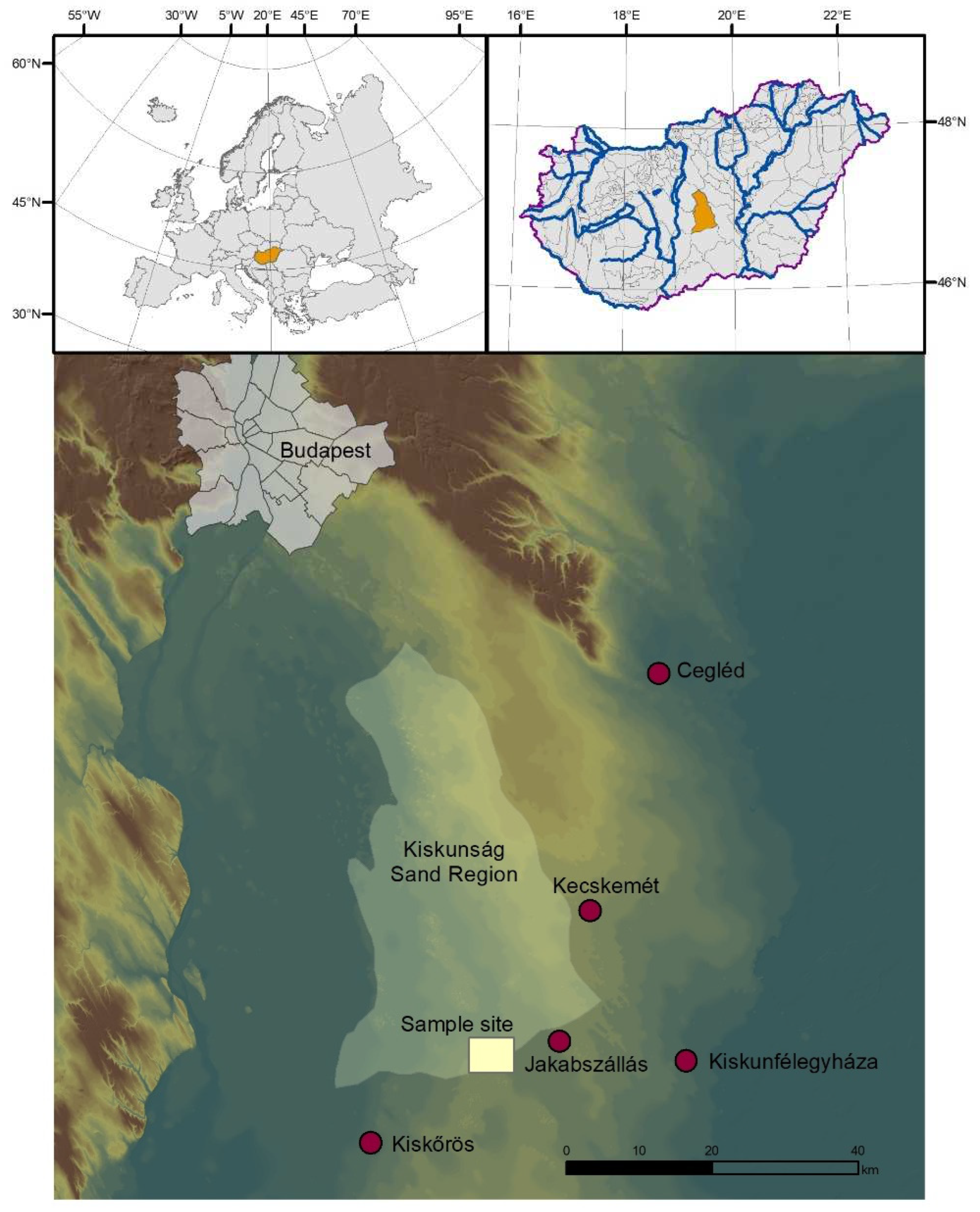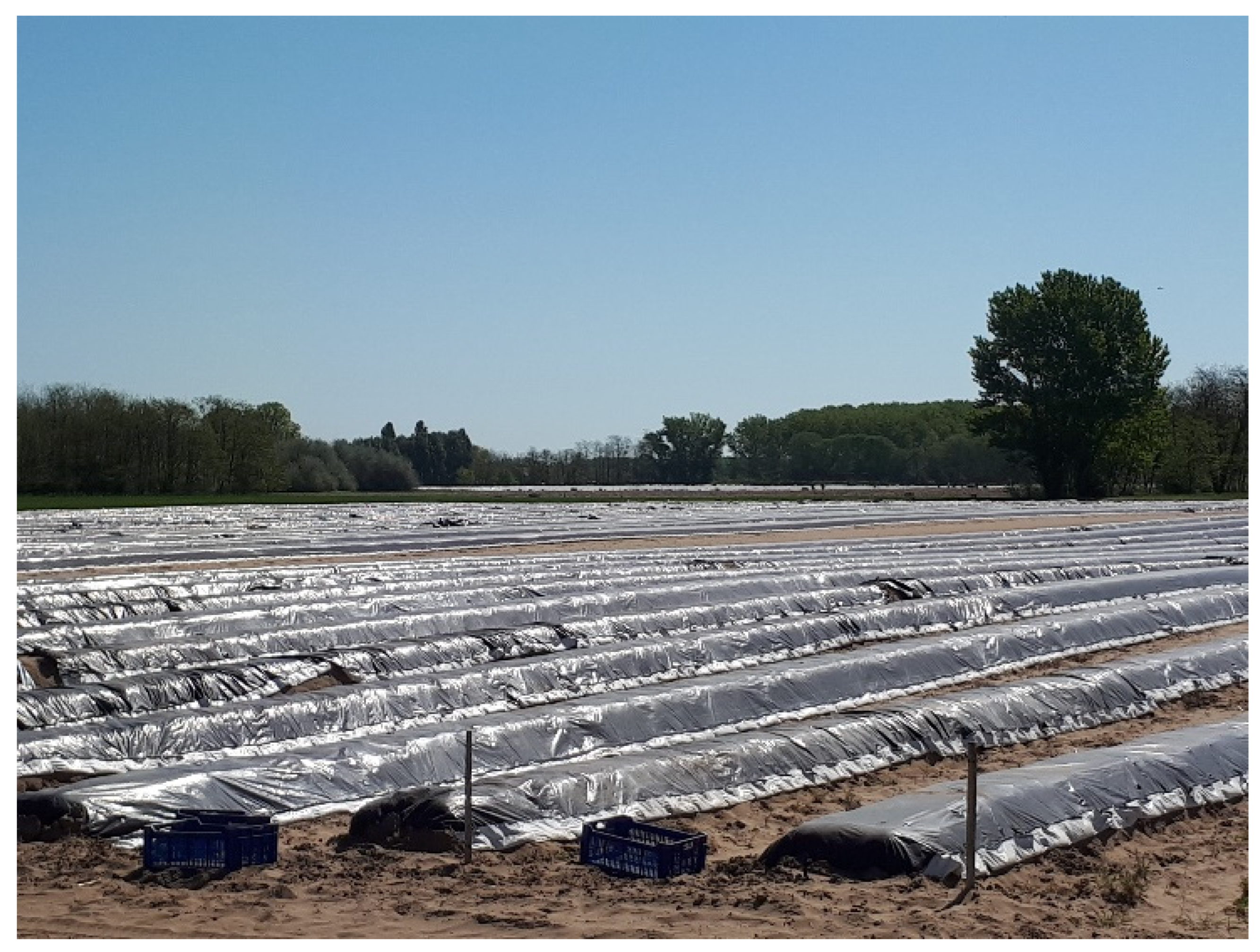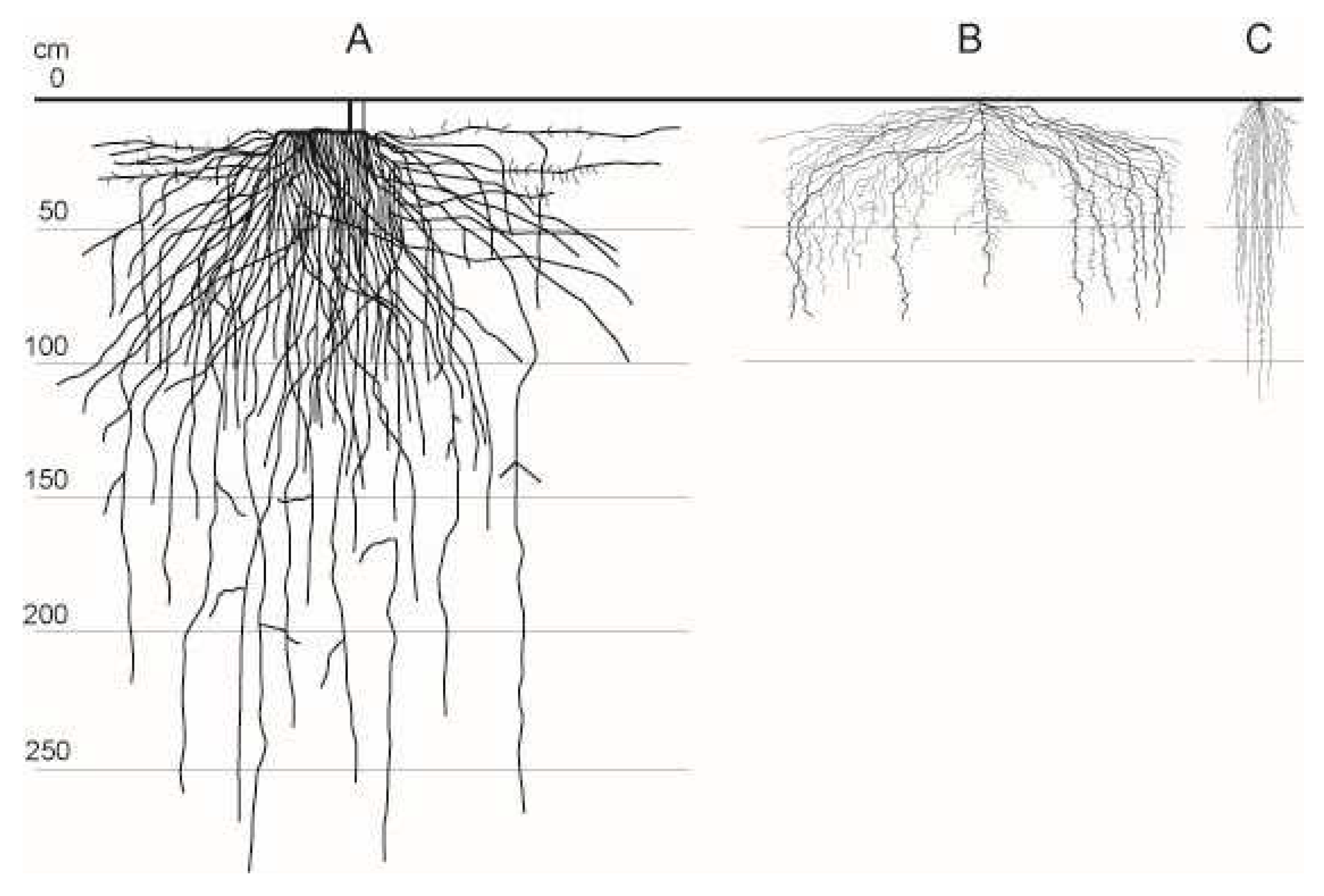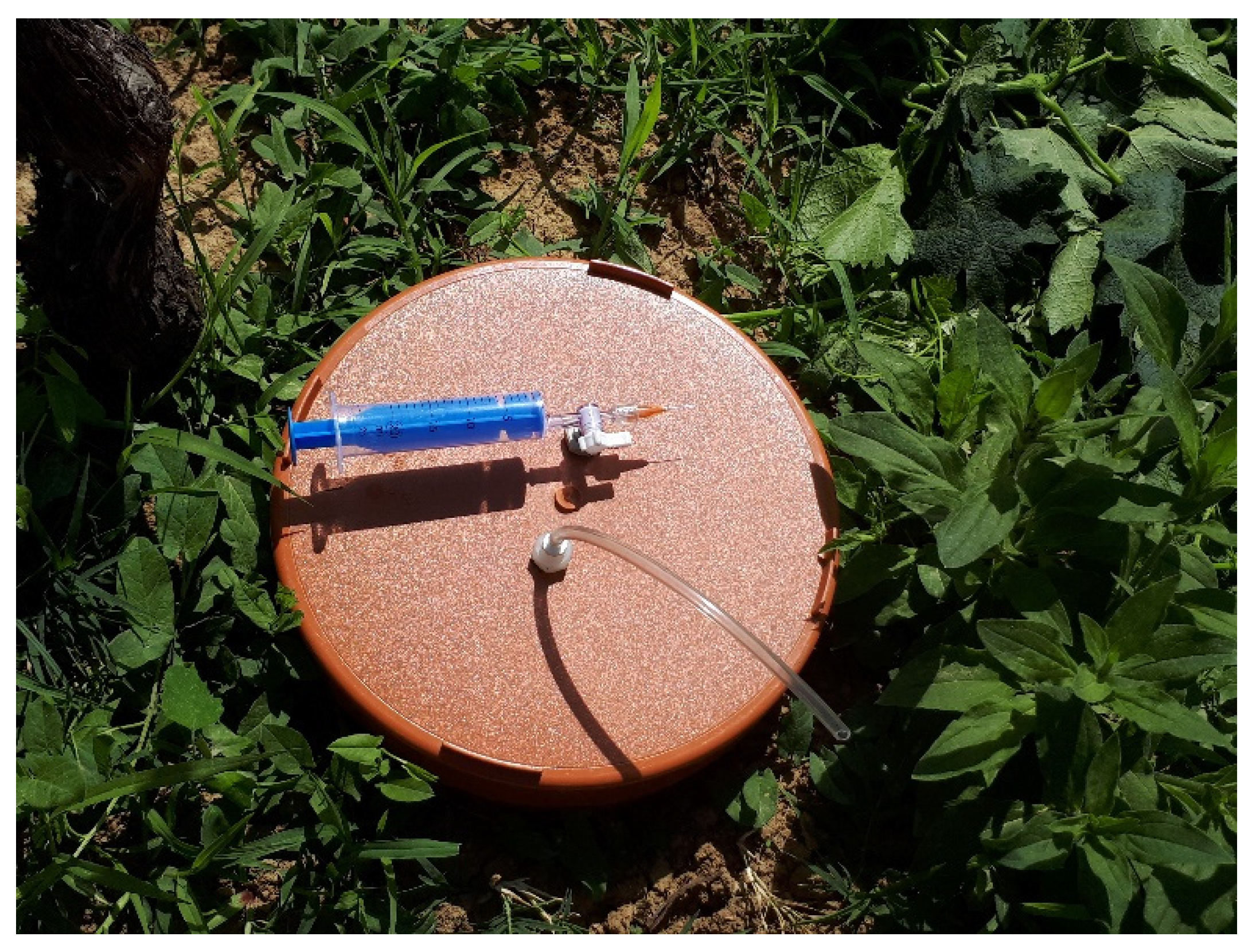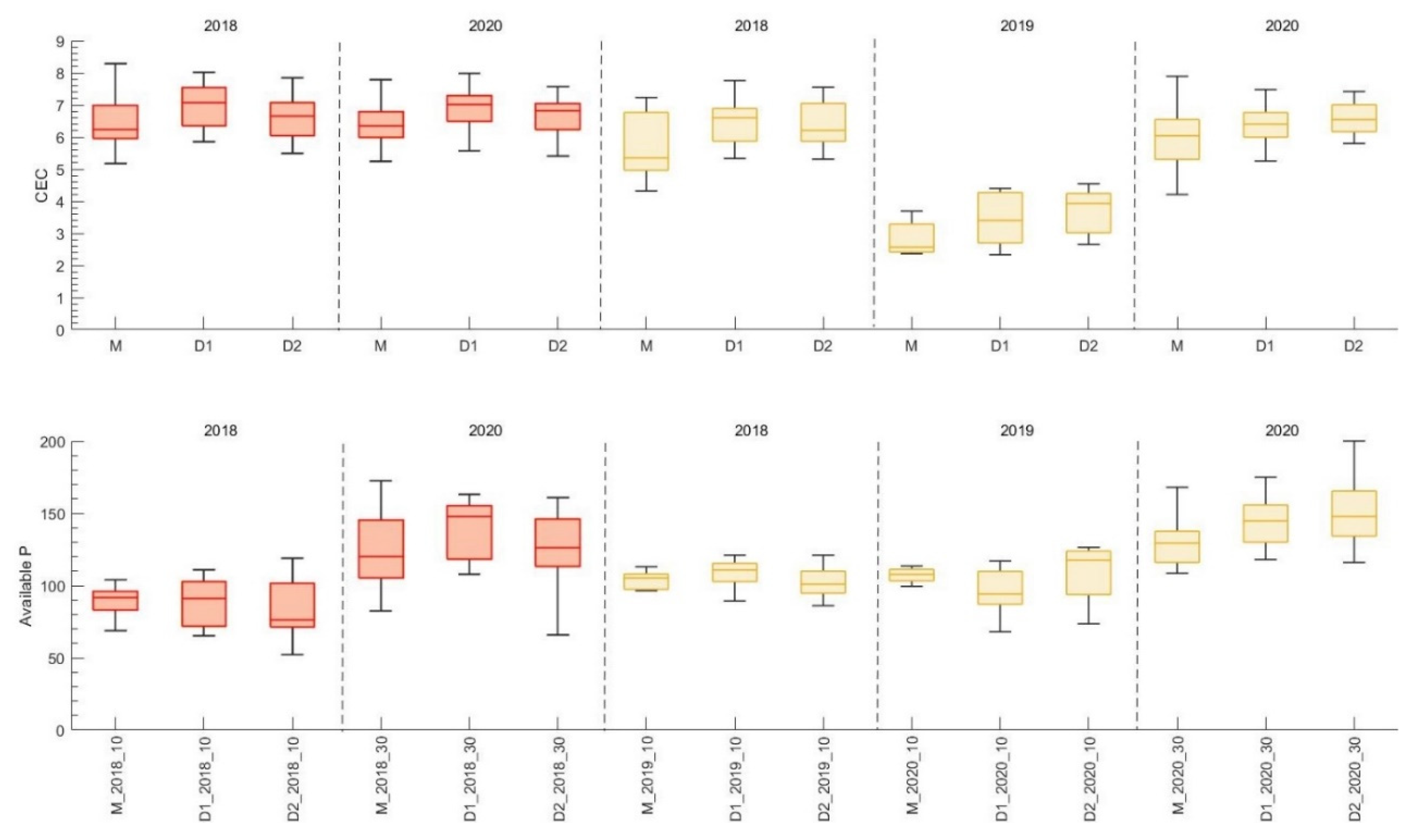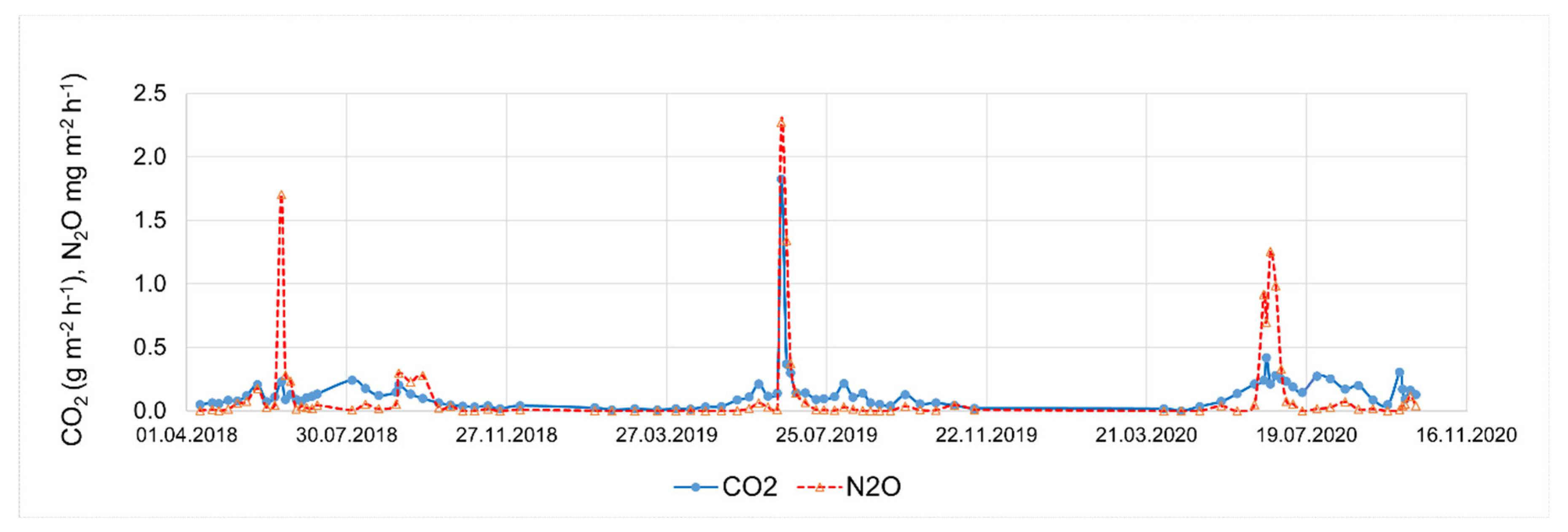1. Introduction
In the temperate belt monoculture in crop cultivation has led to widespread degradation of fertile land and landscape diversity [
1] and result in enhanced economic risk [
2] concerning food supply. At the same time, heavily modified agricultural landscapes have also become vulnerable to climate change. Blown-sand mantled alluvial fans of particularly unfavourable water balance are as vulnerable in this respect as any wetland [
3].
Presently, desertification in the tropical belt and aridification at mid-latitudes [
4,
5] are viewed as major climate change related hazards to the well-being of humankind. Deserts and desertification-affected areas extended over 41.3% of the Earth’s land area in 2000 [
6]. The largest desert, the Sahara, for instance, expands at a rate of 11,000 km
2 y
-1 [
7] and the arid areas of other continents show similar trends. The updated FAO estimate for world desertification rate is 120,000 km
2 y
-1 [
5]. Extratropical areas, such as Hungary, are also affected [
8].
The Farm to Fork strategy of the European Union for a fair, healthy and environmentally-friendly food system [
9] will also be implemented in arid lands. It includes concepts on which measures directed to make crop cultivation more sustainable and to increase diversity can be based [
10]. Crop diversification may be an important pillar of this strategy. As defined, crop diversification means that plants at different development stages are present in the same field at different times with the purpose of improving the level of various ecosystem services. Crop rotation, strip harvesting, genetic diversity and weed strips in monoculture, polyculture, agroforestry, mixed use of the landscape are long applied and efficient means of diversification [
11]. Intercropping can be added to the list as a further solution.
Some potential, but automatically realizable, benefits of farm-level crop diversification in multiannual crop plantations are [
12]:
Increases incomes of small farms;
Helps withstand fluctuation in commodity prices;
Provides resilience to extreme weather conditions (surplus rainfall or drought);
Reduces the costs of production;
Provides more varied and healthy food, both for humans and livestock;
Diminishes pest hazards and weeds growth;
Enhances beneficial pollinator populations;
Improves soil quality on the long term;
Broadens employment.
Diversification, however, can also be interpreted in a broader sense. Some ecologists are convinced that both wild and cultivated plants are sociable beings and prefer each other’s company to living alone (i.e., in monocropping) [
13,
14]. Through the optimal selection of cover crops diversification may have socio-economic benefits as well and present itself as the best way of the exploitation of natural potentials [
15,
16].
The Diverfarming project (2017-2022) within the EU Horizon 2020 program aimed at the evaluation of the impacts of crop diversification and low-input interventions [
17]. Diverfarming is intended to enhance the long-term resilience, sustainability and economic revenues of agriculture across the EU by assessing the real benefits and minimising the limitations, barriers and drawbacks of diversified cropping systems using low-input agricultural practices that are tailor-made to fit the unique characteristics of six EU pedoclimatic regions (the southern and northern Mediterranean, Atlantic, continental, Pannonian and boreal regions). The case studies also covered a wide range of cultures from perennial woody plants such as citrus crops, olive plantations, vineyards as well as annual fruits such as sugar melon, vegetables (tomato, peas), cereals, fodder crops etc. Other Horizon 2020 projects have also been directed at better provision of ecosystem services (soil fertility, carbon sequestration, reduction of greenhouse gas emissions, soil erosion and contamination) in Europe [
18,
19].
In the most comprehensive overview of the topic, Beillouin, D. et al. [
16] analyzed the available literature (95 meta-analyses from 85 countries) to assess the effects of crop diversification in agroecosystems. They found that crop diversification significantly enhanced crop productivity (median effect +14%) and the associated biodiversity (+24%, i.e., the biodiversity of non-cultivated plants and animals). In addition, several supporting and regulating ecosystem services including water quality (+51%), pest and disease control (+63%) and soil quality (+11%) were also improved.
Members of the Diverfarming consortium collected information on the stakeholders’ perceptions of barriers and opportunities for implementing farming practices and crop diversification strategies in intensive rainfed and irrigated cereal-based cropping systems in Italy [
20]. To make the introduction of diversification solutions easier, they selected cover crops which are already cultivated there as monocultures and adapted to the local pedoclimatic conditions.
In Hungary the area hardest hit by drought hazard is the Kiskunság sandy region in the centre of the Danube-Tisza Interfluve [
4,
21,
22]. The situation is exacerbated by the constantly dropping groundwater levels [
8]. Sporadic years with higher-than-average precipitation could disrupt but not turn the aridification trend [
23]. Reduced soil moisture contents on the surface provide favourable conditions for wind erosion which further reduces soil fertility which is low anyhow [
24,
25]. Consequently, in the Kiskunság the environmental problems of land use equally reflect unfavourable climatic and soil properties (
Figure 1).
In the study area of the Diverfarming experiment a multiannual horticultural crop, asparagus is grown. The broad alleys between asparagus rows allow the application of intercropping as a means of crop diversification. The intercropped cover crops were assumed to promote soil moisture retention, enrich the soil in organic matter with residues (green manuring) and reduce wind velocity (and thus soil erosion) through enhanced surface roughness.
In addition, low-impact interventions are also used in asparagus cultivation involving the application of ’greensoil’ (granulate organic matter mixed with mineral fertilizer) and (from November to March) cellulose-decomposing bacteria; integrated pest control and regulated irrigation.
Several ways of sustainably combating drought and wind erosion hazard have been proposed [
26]:
1. Enhancing soil moisture preservation through preventing or hindering desiccation. This would require regular irrigation to allow crusting, but under the climatic conditions of the study area it cannot be implemented on the long run.
2. Ensuring better protection of the surface by vegetation cover, reducing wind energy by forest belts [
27] or providing a contiguous cover by denser cropping. However, this is jeopardized by water scarcity almost permanent throughout the growing season.
3. Mulching could increase soil organic matter content and thus soil aggregation. Organic matter in itself contributes to soil moisture conservation, balances soil temperature and pH. However, for the decomposition of organic matter by microbial activity [
28], the soil moisture content available on the long term is usually not adequate. The aggregate stability of the wind-blown sand is also low because of the minimum clay content. (The latter is only higher in the buried paleosol horizons, which attest to wetter spells.)
In the international literature numerous techniques are proposed to combat wind erosion and, at the same time, increase soil fertility (organic matter content). In a pilot study in Kuwait Burezq, H. [
29] stabilized native blown-sand soil (T1) with biochar and animal manure (T2) and T3 with biochar, animal manure, Urea Formaldehyde (UF), Sulfonated Naphthalene Formaldehyde (SNF), and Polyvinyl Alcohol (PVA) (T3). The erosion rate of native sandy soil (T1) has increased from 3.33, 4.77 to 7.35 g m
-2 min
-1 when wind speed was increased from 5, 10 to 15 m s
-1, respectively. At the same wind speeds, the measured erosion loss was 1.99, 3.07, 5.32 g m
-2 min
-1 for T2 and 1.17, 2.6, 4.24 g m
-2 min
-1 for T3. In asparagus fields of more cohesive soil in the UK, Niziolomski, J. C. [
30] found compost application less effective than straw. With straw mulch applied at 5 t ha
-1, overall soil loss was reduced by 72% soil erosion rates just above 1.4 t ha
-1 y
-1, a tolerable value in the EU.
2. Study area and methods
A unique feature of the Kiskunság landscape used to be its high landscape-level diversity, the mosaical pattern of extremely dry sand dunes alternating with saline wetlands between them. The contrast between these habitat types, however, is getting more and more subdued [
31] and landscape pattern is becoming simpler.
In the physico-geographical divisions of Hungary [
32] the study area in the outskirts of the village Jakabszállás belongs to the alluvial fan of the Danube, right on the southern boundary between the Kiskunság and Bugac sand regions (
Figure 2.). It has a calcareous blown-sand soil (in the WRB classification system: Calcic Arenosol). The environmental properties are extremely unfavourable for cultivation [
33,
34]: sand fraction is predominant with 90-99%, while clay contents are minimal (0-0.3%). Low organic matter contents (total organic carbon: 1.5-3.5 g kg
-1) and the virtual absence of particles in the >250 μm diameter fraction hinders aggregation. Inorganic carbonates are found in medium amounts (3.5-4.5%). Soil fertility and the choice of agricultural crops are first of all limited by the low soil moisture content, its extreme seasonal distribution and the low water retention capacity of the topsoil [
35,
36,
37]. Frequent desiccation exposes the soil to sand storms which carry away large amounts of low-density humus particles.
2.1. Estimation of climatic water deficit
As shown by data from the closest principal meteorological station (Kecskemét, 46.91°N, 19.76°E, 112 m above sea level; registration number: 12970), situated at 25 km distance, long-term (1880–2018) mean annual temperature is 10.7°C and annual average precipitation in the study area is 538 mm. The Thornthwaite annual potential evapotranspiration for 1951-2000 is ca. 750 mm. (With unabated temperature rise, potential evaporation is increasing and thus water availability is deteriorating.) In the years of the experimentation annual temperature and precipitation amounted to 12.3°C and 540.5 mm in 2018; 12.5°C and 498.75 mm in 2019; 11.9°C and 587 mm in 2020. To establish evaporation, Palmer-type one-layer bucket model used in the traditional calculation of Palmer Drought Severity Index [
38,
39] was applied. The necessary soil parameters (water capacity in the field and at dew-point, actual soil water reserves, root depth etc.) were monitored in the Diverfarming project. Monthly potential evaporation (PET) was also computed from the data of nearby synoptic meteorological stations using the FAO and the Thornthwaite methods [
40,
41].
2.2. Crop treatments
Given the limited choice of crops which can be grown in the region, an irrigated asparagus field of 1.3 ha area was selected for the experiment. Asparagus cultivation technology involves foil-covered, ca. 30-cm high ridges [
42] built mechanically parallel to the prevailing wind direction (
Figure 3), thus enhancing wind channel effect and wind erosion.
Asparagus is a high-value, but also highly labour- and cost-intensive crop. In recent years both its harvest area and yields have shrunken considerably in Hungary: in 2006 (predominantly white) asparagus was cultivated in almost 2000 ha area [
42], while in 2021 in around 1400 ha. The yields ranged from 4.5 t ha
-1 to 6.5 t ha
-1; 60-90% were exported, mostly to Germany. A major reason of decline is the lack of labour force, intensified by the Covid-19 epidemic, and the low purchase prices paid to producers by traders. (Mechanized harvesting is technologically possible, the costs of machinery, however, far exceed the opportunities of Hungarian farmers.)
In the semiarid environment irrigation is a crucial requirement for profitable asparagus cultivation. Campi, P. et al. [
43] claim that while full irrigation maximizes asparagus yields, reduced irrigation in critical phenological phases (i.e., 50% of evapotranspiration from the first fern flush until the end of the growing season) also provides acceptable yields. Therefore, in the study area, regulated deficit irrigation (RDI) was originally planned when asparagus was planted in 2010. The irrigation system operated for six years during which the perennial crop was well established, but it was blocked just before the start of experimentation and, therefore, no further irrigation could be employed and rainfed cultivation was practiced.
Additional inputs also make asparagus production cost-effective. In the experiment management activities began with the preparation of ridges in February or March, depending on weather (frost) conditions. The fern was cut and the ridges were removed in mid-June.
The nutrient demands of asparagus plantations in Hungary are summarized in literature [
44] as follows. To induce shoot (spear) growth, the uppermost 60 cm soil layer should include 250 mg P
2O
5 kg
-1 and 300 mg K
2O kg
-1. For fertilization this means the following amounts: nitrogen (NO
3-, NH
4+): 160 kg ha
-1; phosphorus (P
2O
5): 46 kg ha
-1; potassium (K
2O): 146 kg ha
-1. Microelements (Ca, Mg, S, Cu, Zn, Mn) are optimally added as foliar fertilization.
Accordingly, in the study plots NPK fertilization (around 300 kg ha-1) took place on two occasions per year (two-thirds of the annual dose in June, and one-third in August), additionally calcium-, magnesium- and sulphur-oxides were also applied.
Further treatments are necessary for weed control beginning with the emergence of shoots in early June. Avoiding tillage and increasing soil health, quick-growing cover crops such as fescues, perennial ryegrass, and clover are planted in the alleys. At Jakabszállás intercropping was established in April every year.
The need for plant protection is motivated by a great variety of pests affecting asparagus [
45]: crown and root rot (Fusarium spp.), fungal asparagus rust (Puccinia spp.), grey mould
(Botrytis cinerea), leaf spot
(Cercospora asparagi), asparagus beetle
(Crioceris asparagi) and others. At Jakabszállás plant protection started with weeding by rolling or rotating in early June (as required) and then also involved the application of pesticides (with effective substance metribuzine) in June, a combination of fungicides (difenoconazole, azoxystrobin and dyoctil- potassium-sulfosuccinate, metiram, tebuconazole, boscalid) with insecticide (alpha-cypermethrin) in the end of July. Fungicide and insecticide treatment was repeated in late August or early September depending on weather. In some years additional mechanical weeding (by rolling or rotating) also became necessary. Occasionally, when beetles attack, the spraying with some insecticide generating emulsion (esfenvalerate and acetamiprid) could be applied. This brief summary illustrates the wide variety of necessary plant protection interventions in the asparagus field.
2.3. Crop diversification options
When selecting herbs for intercropping, it is important to avoid competition for water. In the experiment two diversifications were introduced to raise the provision level of ecosystem services: asparagus monocrop (M, control) and plots diversified with fodder pea (D1) and oat (D2) sown in the alleys between ridges. Both the leguminous pea, which binds nitrogen from the atmosphere and rich in phosphorus and potassium, and oat, which is also rich in nutrients and tolerant to weather extremes are widely grown as fodder crops in the Kiskunság region. A comparison of root depths shows some overlaps, but the typical depth of the hair root zone is sufficiently different (
Figure 4) and precludes strong competition [
46].
2.4. Monitoring soil properties and soil moisture
In the Diverfarming project the following soil properties were monitored [
47]: bulk density (g cm
-3); soil water content at wilting point of 1500 kPa and at field capacity (cm
-3 cm
-3); soil texture (sand, silt and clay contents, %); pH; electrical conductivity (dS m
-1); total organic carbon (mg g
-1); nitrogen content (mg g
-1); cation exchange capacity (cmol kg
-1); sum of bases (cmol kg
-1); carbonate content (%); rock fragments and gravels (>2 mm) (%); actual field moisture content (cm
-3 cm
-3). Monitoring techniques rely – among other sources – on Huber, S. et al. [
48] and are described in a Handbook [
47].
Soil moisture content impacts on many fundamental biophysical processes [
49]: on the germination, plant growth, microbial decomposition of the soil organic matter, and nutrient transformations in the root zone. Heat and water transfer at the land–atmosphere interface is also dependent on moisture content. For soil moisture monitoring Time Domain Reflectrometry (TDR) were used (Decagon Devices Inc., Pullman, WA, USA). The sensors were placed at -10, -30, and -100 cm depths in the alleys between ridges. The method is based on permittivity, which is the measure of a material’s ability to resist an electric field [
50].
2.5. Wind erosion measurement
The amount of wind-transported sediment was measured in a 100-m cross-section in traps placed on the ground surface and at 30 cm, 200 cm and 400 cm heights above the surface. The wind velocity data from the observations of the meteorological station were evaluated. The critical velocity for aeolian sand transport was established from the results of wind tunnel experiments [
51,
52]. Under the conditions of the Kiskunság sand region previous research estimated critical entrainment velocity at 6 ms
-1 for 10 cm height above the ground surface [
25]. (Although critical velocity also varies with soil organic matter content, in the case of blown-sand soils it has no significance.) In the deposited material total carbon and inorganic carbonate contents were determined using the wet combustion technique [
53].
2.6. Emission of greenhouse gases
In the Pannonian pedoclimatic region half of the greenhouse gas (CO2, CH4 and N2O) emissions derives from agriculture. Above 10 °C soil temperature, CO2 emission is continuous and N2O is released from the nitrification and denitrification processes. On the other hand, soil is a CH4 sink, and methane is converted first into methanol (CH3OH) and finally to CO2 by methanotrophic bacteria.
For gas measurements performed on 25-33 occasions in a year at higher than +5 °C soil temperature, the static chamber method was applied with timing adjusted to fertilization dates [
54]. Parallel sampling was carried out at 0, 10, 20 and 30 minutes from altogether 18 closed chambers (
Figure 5). CO
2 and CH
4 concentrations were measured by gas chromatography with flame ionization detector (FID) and for N
2O by electron capture detector (ECD). Fluxes in the soil were computed from the accumulation of concentration and interpreted in function of weather and plant phenology.
3. Results and discussion
The efficiency of diversification heavily depended on the soil coverage provided by the different options. Utilizing water from sporadic showers, pea and oat ensured almost perfect (>85%) cover from the second year of the experiment on. Unfortunately, this positive effect of cover crops was limited to a relatively short period, from late April to early June. This means that in early spring, when usually strong winds blow, the ground remains uncovered.
Soil cover and wind erosion risk are affected by the frequency of total soil desiccation (soil moisture content: <0.02 cm
3 cm
-3) as well as
precipitation (Figure 6). Fortunately, for a longer spell in the second year of the experiment soil moisture reached a satisfactory value (0.1 cm
3 cm
-3)
(Figure 7). For the conservation of soil moisture diversification D1 (asparagus + pea) was preeminent, especially in the deeper soil layer (
Figure 7).
The achieved nutrient contents showed a variable picture. Total N contents in the uppermost 10-cm soil layer amounted to 310 mg kg-1 on the average with peaks in the first year, when more fertilizers were applied. Over the rest of the experimentation period no significant differences were observed between the diversifications D1 and D2 in this respect. In the deeper 10-30-cm layers the varying intensity of microbial activity generated a great variation in nitrogen supply: it was 60 mg kg-1 in asparagus monocropping (M), 110 mg kg-1 in D1 (pea) and as low as 50 mg kg-1 in D2 (oat).
In the diversifications
pH values showed a gradual decrease. With similar rates of fertilization, this could be explained by the growing acid release by the roots of developing cover crops.
Electrical conductivity remained at high levels due to the chemical treatments of crops.
Cation exchange capacity (CEC) and the sum of bases values have risen over the three-year experimentation and indicate some improvement in nutrient supply
(Figure 8a
). The available
phosphorus reserves peaked in 2020 and in the diversified plots (particularly at 0-10 cm soil depth –
Figure 8b).
As it had been expected, competition between the main crop (principal root zone at 20-120 cm depth) and the cover crops (at 0-20 cm for pea and 0-70 cm for oat) for moisture and nutrients was minimal. Although very low clay contents (low aggregation potential) exclude the enrichment of the soil with nitrogen, total organic carbon content could be raised through adding crop residues to the soil. (However, the decomposition rate of such residues is low in the dry environment.)
What were the regularities in the fluxes of
greenhouse gases? In winter emissions, which depend on temperature, are negligible
(Figure 9). Peaks of N
2O coincide with fertilization events (nitrification of ammonia) and higher CO
2 emissions [
55]. Total CO
2 emission amounted to 20.7 t ha
-1 and N
2O emissions to 14.5 kg ha
-1 over the three years. Since the global warming potential (GWP) of N
2O 300-fold exceeds that of CO
2, its total CO
2-equivalent emission is 4.36 t ha
-1; therefore, the total greenhouse gas emission of soils was 25.0 t ha
-1 in CO
2 equivalent. The findings are in harmony with other low CO
2 emission values above low vegetation [
56].
Soil is a sink for methane. CH4 absorption rate is low compared to CO2 emissions: only -3.68 kg ha-1 over the three years, which is merely 0.05% of CO2 emissions (in carbon content).
Nitrogen-fixing bacteria and mineral fertilizer application led to increased N
2O emission in D1 plots (with pea). The findings, however, are not in accordance with data from literature [
57,
58], where an opposite trend was held probable for legumes. The higher nitrogen content of the soil of D1 plots cannot explain fully the enhanced N
2O emission, because D2 plots also had higher emission levels due to the incorporation of cover crop residues into the soil [
59]. Our results are supported by Basche, A. D. et al. [
60], who claim that leguminous cover crops may increase, while other herbs may decrease N
2O emission. Literature also indicates that where organic cultivation is possible, lower greenhouse gas emissions [
61], higher shelf life and higher quality of asparagus spears [
62] can be achieved.
From the erosion measurement the vertical profile of aeolian transport was defined. The amount of sand saltated 15 cm above the ground surface reached an average of 2,130 kg y-1 over the experimentation period. At 200 cm height the trapped dust weighed 105.39 kg, at 400 cm, however, only 26.75 kg. The sediment traps closest to the surface captured sand with a median diameter of 174 µm, at +15 cm it was 134 µm, at +200 cm 118 µm and at +400 cm only 42 µm (coarse silt).
Total organic carbon (TOCw) and inorganic carbonates in the sediment traps closely reflected the influence of height above ground surface.
The success of the various diversifications varied with years. However, disregarding 2019, when drought prevented the normal development of cover crops, diversification D2 (with oat intercropped) mitigated the rate of wind erosion most efficiently – by 25%, i.e., from 2.6 t ha-1 y-1 to 1.9 t ha-1 y-1 compared to asparagus monoculture.
4. Conclusions
The introduction of crop diversification in the Kiskunság sand region can involve the following environmental benefits:
1. Higher organic matter contents and cation exchange capacity point to increased soil fertility. Over the longer term mycorrhizal associations are established between the main crop and the cover crops.
2. More complete soil cover and reduced cultivation diminish desiccation hazard and ensures the necessary moisture in the topsoil for cover crops too.
3. The socio-economic benefits are difficult to identify in the short term. The introduction of diversification requires additional costs, which may deteriorate compatitiveness. At the same time, selling a properly selected intercrop can be a source of income. (In the experiment, the value of the intercrops was difficult to compare with that of the exportable asparagus.) Farm competitiveness primarily depends on input costs, such as fertilization, plant protection and labour.
Although measurements were limited to only three growing seasons, certain conclusions can perhaps still be drawn from them regarding soil fertility, soil moisture conservation and wind erosion risk.
1. The condition of the soil surface was the same in all plots, the differences in sediment transport by the wind were caused by diversification.
2. The particle size of the entrained dust fraction stabilizes at a height of 400 cm, where the proportion of the 0.7-8 μm fraction (fine organic matter) increases. During periods of drought, dust storms significantly reduce soil fertility.
3. Complete desiccation of the soil surface often occurred during the experimental period. In such cases, there is no solution to protect the soil, so diversification does not help either. At times of minimal wetting, crop diversity and the use of cover crops in broad alleys can reduce wind erosion.
4. As cover crop, oat ensures higher surface roughness and better soil coverage, and protects against wind erosion somewhat better than fodder pea. Dust generation and humus loss are also more limited if oat is sown in the alleys. However, this advantage is possibly compensated by the ability of pea as a leguminous plant to fix nitrogen. Ultimately, both cover crops have a place in diversification planning.
Author Contributions
Conceptualization: D.L. and J.D.; Methodology: D.J., T.W, L.H.; Formal Analysis: S.C.; Investigation: J.D.; Resources: J.D.; Data Curation: J.D. and S.C.; Writing – Original Draft Preparation: J.D. and D.L.; Writing – Review & Editing: D.L. and S.C.; Visualization: J.D. and S.C.; Supervision: T.W. and L.H.; Project Administration: J.D.; Funding Acquisition: D.L.
Funding and Acknowledgments
Authors are grateful for financial support for the European Commision for financial support in the framework of the H2020 Diverfarming project (contract number: 728003), for the land owner Dávid Nedelkovics to grant permission for the experiment in his property and for Ferenc Tarjányi, who supplied production data. The meteorological database was collected within the COST FAIR NEtwork of micrometeorological measurements (FAIRNESS, No.: CA20108) program.
Conflicts of Interest
The authors declare no conflict of interest.
References
- Bàrberi, P.; Moonen, A.C. (Eds.) Reconciling agricultural production with biodiversity conservation; Burleigh-Dodds Science Publishing: Cambridge, UK, 2020. [Google Scholar] [CrossRef]
- Griffiths, B. S.; Römbke, J.; Schmelz, R. M.; Scheffczyk, A.; Faber, J. H.; Bloem, J. et al. Selecting Cost Effective and Policy-Relevant Biological Indicators for European Monitoring of Soil Biodiversity and Ecosystem Function. Ecol. Indic. 2016, 69, 213–223. [CrossRef]
- Mirzabaev, A.; Stringer, L. C.; Benjaminsen, T.A.; Gonzalez, P.; Harris, R.; Jafari, M.; Stevens, N.; Tirado, C. M.; Zakieldeen, S. Cross-Chapter Paper 3: Deserts, Semiarid Areas and Desertification. In: Climate Change 2022: Impacts, Adaptation and Vulnerability. In Contribution of Working Group II to the Sixth Assessment Report of the Intergovernmental Panel on Climate Change; Cambridge University Press, Cambridge, UK – New York, USA, 2022, 2195–2231. [CrossRef]
- Kertész, Á.; Mika, J. Aridification — Climate change in South-Eastern Europe. Phys. Chem. Earth, Part A: Solid Earth and Geodesy 1999, 24, 913–920. [CrossRef]
- FAO. Action against Desertification; Overview: Desertification and land degradation; FAO: Rome, Italy, 2023; https://www.fao.org/in-action/action-against-desertification/overview/desertification-and-land-degradation/en/.
- Adeel, Z.; Safriel, U.; Niemeijer, D.; White, R.; de Kalbermatter, G.; Glantz, M. Ecosystems and human well-being:; Desertification synthesis: A report of the millennium ecosystem assessment; World Resources Institute: Washington, DC, 2005. [Google Scholar]
- Liu, Y.; Xue, Y. Expansion of the Sahara Desert and shrinking of frozen land of the Arctic. Sci. Rep., 2020, 10, 4109. [Google Scholar] [CrossRef] [PubMed]
- Fehér, Z. Zs.; Rakonczai, J. Analysing the sensitivity of Hungarian landscapes based on climate change induced shallow groundwater fluctuation. Hun. Geogr. Bull. 2019, 68, 355–372. [CrossRef]
- EU Commission. Farm to Fork Strategy. For a fair, healthy and environmentally-friendly food system. European Union, 2020, 23 p. Accessed on 11.05.2023. https://food.ec.europa.eu/system/files/2020-05/f2f_action-plan_2020_strategy-info_en.pdf.
- TEEB. The economics of ecosystems and biodiversity: mainstreaming the economics of nature: A synthesis of the approach, conclusions and recommendations of TEEB. UNEP TEEB: Châtelaine, Geneva, Switzerland, 2010. Accessed on 11.05.2023. https://teebweb.org/publications/teeb-for/synthesis/.
- Lin, B. B. Resilience in Agriculture through Crop Diversification: Adaptive Management for Environmental Change. BioScience, 2011, 61, 183–193. [CrossRef]
- Walia, M. K. Crop Diversification. Extension, University of Nevada: Reno, NV. 2020; FS-20-28. Accessed on 15/04/2023. https://extension.unr.edu/publication.aspx?PubID=3816.
- Borhidi, A. A növények társadalma (Society of plants). In: Gaia zöld ruhája (Gaia’s Green Clothes). 287–308. Akadémiai Kiadó: Budapest, Hungary, 2003. (in Hungarian). https://adoc.pub/borhidi-attila-a-nvenyek-tarsadalma.html.
- Dudley, S. A.; Murphy, G. P.; File, A. L. Kin recognition and competition in plants. Funct. Ecol., 2013, 27, 898–906. [CrossRef]
- Wezel, A.; Casagrande, M.; Celette, F.; Vian, J.-F.; Ferrer, A.; Peigné, J. Agroecological Practices for Sustainable Agriculture. A Review. Agron. Sustain. Dev. 2014, 34, 1–20, Springer: Dordrecht, Netherlands. [CrossRef]
- Beillouin, D.; Ben-Ari, T.; Malezieux, E.; Seufert, V.; Makowski, D. Positive but Variable Effects of Crop Diversification on Biodiversity and Ecosystem Services. Glob. Chang. Biol. 2021, 27, 4697–4710, Wiley Online Library. [CrossRef] [PubMed]
- Zabala, J. A.; Martínez-García, V.; Martínez-Paz, J. M.; López-Becerra, E. I.; Nasso, M.; Díaz-Pereira, E.; Sánchez-Navarro, V.; Álvaro-Fuentes, J.; González-Rosado, M.; Farina, R.; Di Bene, C.; Huerta, E.; Jurrius, A.; Frey-Treseler, K.; Lóczy, D.; Fosci, L.; Blasi, E.; Lehtonen, H.; Alcon, F. Crop diversification practices in Europe: an economic cross-case study comparison. Sustain. Sci. 2023, 18, 2691–2706. [CrossRef]
- Tamburini, G.; Bommarco, R.; Wanger, T. C.; Kremen, C.; van der Heijden, M. G. A.; Liebman, M.; Hallin, S. Agricultural Diversification Promotes Multiple Ecosystem Services without Compromising Yield. Sci. Adv. 6, eaba1715, American Association for the Advancement of Science, Washington, DC., 2020. [CrossRef] [PubMed]
- Bethwell, C.; Burkhard, B.; Daedlow, K.; Sattler, C.; Reckling, M.; Zander, P. Towards an enhanced indication of provisioning ecosystem services in agro-ecosystems. Environ. Monit. Assess. 2021, 193 (Suppl. S1), 269. [Google Scholar] [CrossRef] [PubMed]
- Di Bene, C.; Gómez-López, M. D.; Francaviglia, R.; Farina, R.; Blasi, E.; Martínez-Granados, D.; Calatrava, J. Barriers and Opportunities for Sustainable Farming Practices and Crop Diversification Strategies in Mediterranean Cereal-Based Systems. Front. Environ. Sci. 2022, 10. [Google Scholar] [CrossRef]
- Várallyay, Gy. Magyarország talajainak vízraktározó képessége (Water storage capacity of soils in Hungary). Agrokem. Talajt. 2005, 54, 5–24. (in Hungarian). [CrossRef]
- Kocsis, M.; Dunai, A.; Farsang, A.; Makó, A. Magyarország kistájainak talajspecifikus aszályérzékenysége a szántóföldi növények termésreakciói alapján (Soil-specific drought sensitivity of subregions of Hungary based on yield reactions of arable crops). Földrajzi Közlemények, 2018, 142, 89–101. (in Hungarian). [Google Scholar]
- Kis, A.; Pongrácz, R.; Bartholy, J.; Gocic, M.; Milanovic, M.; Trajkovic, S. Multi-scenario and multi-model ensemble of regional climate change projections for the plain areas of the Pannonian Basin. Időjárás 2020, 124, 157–190. [Google Scholar] [CrossRef]
- Farsang, A.; Bartus, M.; Négyesi, G.; Barta, K.; Szatmári, J. Estimation of nutrient movement caused by wind erosion on chernozems based on wind channel experiments. Geophys. Res. Abstr. 2012, 14, EGU2012-13798. [Google Scholar]
- Négyesi, G.; Lóki, J.; Buró, B.; Bertalan-Balázs, B.; Pásztor, L. Wind erosion researches in Hungary – past, present and future possibilities. Hung. Geogr. Bull., 2019, 68, 223–240. [Google Scholar] [CrossRef]
- Yang, C.-H.; Geng, Y.-X.; Xing, Zh.-F.; Coulter, J. A.; Chai, Q. The Effects of Wind Erosion Depending on Cropping System and Tillage Method in a Semi-Arid Region. Agronomy, 2020, 10, 732. [Google Scholar] [CrossRef]
- Négyesi, G. Mezővédő fásítások tér- és időbeli változásának vizsgálata a Nyírségben – a szélerózió szemszögéből (Spatial and temporal changes in the distribution of shelter belts in the Nyírség – from the aspect of wind erosion). Tájökológiai Lapok, 2018, 16, 113–128. (in Hungarian). [Google Scholar] [CrossRef]
- Swaminathan, C.; Nivethadevi, P.; Pandian, K. Soil Organic Matter Decomposition – Roles, Factors and Mechanisms. In Latest Trends in Soil Sciences Vol. 1.; (ed. Singh Porte, S.); Integrated Publications: New Delhi, India, 2021; pp. 61–91. [Google Scholar] [CrossRef]
- Burezq, H. Combating wind erosion through soil stabilization under simulated wind flow condition – Case of Kuwait. Int. Soil Water Conserv. Res., 2020, 8, 154–163. [Google Scholar] [CrossRef]
- Niziolomski, J. C.; Simmons, R. W.; Rickson, R. J.; Hann, M. J. Efficacy of mulch and tillage options to reduce runoff and soil loss from asparagus interrows. Catena, 2020, 191, 104557. [Google Scholar] [CrossRef]
- Biró, M.; Révész, A.; Molnár, Zs.; Horváth, F.; Czúcz, B. Regional habitat pattern of the Danube-Tisza Interfluve in Hungary II The sand, the steppe and the riverine vegetation, degraded and regenerating habitats, regional habitat destruction. Acta Bot. Hung., 2008, 50, 19–60. [Google Scholar] [CrossRef]
- Natural Landscapes. In: Kocsis, K. (editor-in-chief) National Atlas of Hungary. The natural environment. Geographical Institute, Research Centre for Astronomy and Earth Sciences, Hungarian Academy of Sciences, Budapest, Hungary. 2019, 126–127.
- Farkas, J. Zs.; Hoyk, E.; Rakonczai, J. Geographical analysis of climate vulnerability at a regional scale: the case of the Southern Great Plain in Hungary. Hung. Geogr. Bull., 2017, 66, 129–144. [Google Scholar] [CrossRef]
- Farkas, J. Zs., Kovács, A. D. Nature conservation versus agriculture in the light of socio-economic changes over the last half-century–Case study from a Hungarian national park. Land Use Policy 2021, 101, 105131. [CrossRef]
- Cserni, I.; Pető, J.; Hüvely, A. A Duna-Tisza közi homokhátság múltbeli, jelenlegi és jövőbeli kutatási eredményei és lehetőségei (Research and perspectives of the Danube-Tisza Sand Region in the past, present and future). Economica, 2015, 4, 12–20. (in Hungarian). [Google Scholar] [CrossRef]
- Szabó, A.; Gribovszki, Z.; Kalicz, P.; Szolgay, J.; Bolla, B. The soil moisture regime and groundwater recharge in aged forests in the Sand Ridge region of Hungary after a decline in the groundwater level: an experimental case study. J. Hydrol. Hydromech., 2022, 70, 308–320. [Google Scholar] [CrossRef]
- Trásy-Havril, T.; Szkolnikovics-Simon, S.; Mádl-Szőnyi, J. How Complex Groundwater Flow Systems Respond to Climate Change Induced Recharge Reduction? Water, 2022, 14, 3026. [Google Scholar] [CrossRef]
- Palmer, W. C. Meteorological Drought. U.S. Research Paper 45. Indicator codes CLIM 029, LSI 007. US Weather Bureau: Washington, DC, 1965; 58 p. Accessed on 10.03.2023. https://www.ncdc.noaa.gov/temp-and-precip/drought/docs/palmer.pdf.
- Ács, F.; Breuer, H.; Szász, G. Estimation of actual evapotranspiration and soil water content in the growing season. Agrokem. Talajt., 2007, 56, 217–236. [Google Scholar] [CrossRef]
- Lakatos, M.; Weidinger, T.; Hoffmann, L.; Bihari, Z.; Horváth, Á. Computation of daily Penman-Monteith reference evapotranspiration in the Carpathian Region and comparison with Thornthwaite estimates. Adv. Sci. Res., 2020, 16, 251–259. [Google Scholar] [CrossRef]
- Szalai, V.; Weidinger, T.; Dezső, J. Párolgásbecslések hazai spárga és szőlőültetvényeken (Estimation of evaporation in asparagus and grapevine plantations of Hungary). Légkör, 2021, 64, 5–10. (in Hungarian). [Google Scholar]
- Erdős, Zs.
A genotípus és tápanyagellátási forma hatékonyságának vizsgálata halványított spárgában (Investigation of the efficiency and genotype and nutrient recharge in white asparagus)
. PhD Thesis, Kerpely Kálmán Doctoral School, University of Debrecen, Debrecen, Hungary, 2019. 201 p (in Hungarian).
- Campi, P.; Mastrorilli, M.; Stellacci, A. M.; Modugno, F.; Palumbo, A. D. Increasing the effective use of water in green asparagus through deficit irrigation strategies. Agric. Water Manag., 2019, 217, 119–130. [Google Scholar] [CrossRef]
- Fehér B.-né. A spárgaültetvények tápanyagellátása (Nutrient supply of asparagus plantations). Kertészet és Szőlészet, 2011, 17. (in Hungarian). (in Hungarian) Accessed on 13.06.2023. https://magyarmezogazdasag.hu/2011/04/27/spargaultetvenyek-tapanyagellatasa.
- Kalomira, E. Asparagus diseases. Eur. J. Plant Sci. Biotechnol., 2007, 1, 76–83, Accessed on 11.06.2023. http://www.globalsciencebooks.info/Online/GSBOnline/images/0706/EJPSB_1(1)/EJPSB_1(1)76-83o.pdf.
- Drost, D.; Wilson, D. Monitoring root length density and root biomass in asparagus (Asparagus officinalis) with soil cores. N. Z. J. Crop Hortic. Sci., 2003, 31, 125–137. [Google Scholar] [CrossRef]
- Álvaro-Fuentes, J.; Lóczy, D.; Thiele-Bruhn, S.; Zornoza, R. (Eds.) Handbook of Plant and Soil Analysis for Agricultural Systems; Crai Ediciones, Universidad Politécnica de Cartagena: Cartagena, Spain, 2019. [Google Scholar]
- Huber, S.; Prokop, G.; Arrouays, D.; Banko, G.; Bispo, A.; Jones, R. J. A.; Kibblewhite, M. G.; Lexer, W.; Möller, A.; Rickson, R. J.; Shishkov, T.; Stephens, M.; Tóth, G.; Van den Akker, J. J. H.; Várallyay, G.; Verheijen, F. G. A.; Jones, A. R. (Eds.) Environmental Assessment of Soil for Monitoring: Volume I Indicators & Criteria, EUR 23490 EN/1, Office for the Official Publications of fthe European Communities: Luxembourg, 2008; 339p.
- Bittelli, M. Measuring Soil Water Content: A Review. Horttechnology, 2011, 21, 293–300. [Google Scholar] [CrossRef]
- Davood, N.-K.; Shorafa, M.; Heidari, A. Estimating Soil Water Content from Permittivity for Different Mineralogies and Bulk Densities. Soil Sci. Soc. Am. J., 2012, 76, 1149–1158. [Google Scholar] [CrossRef]
- Bartus, M.; Barta, K.; Szatmári, J.; Farsang, A. Modeling wind erosion hazard control efficiency with an emphasis on shelterbelt system and plotsize planning. Z. fur Geomorphol., 2017, 61, 123–133. [Google Scholar] [CrossRef]
- Bartus, M.; Barta, K.; Szatmári, J.; Farsang, A. Csongrád megye talajainak szélcsatorna kísérletekre alapozott szélerózió veszélyeztetettség becslése (Windtunnel experiments for wind erosion risk estimation of soils in Csongrád County). Agrokem. Talajt., 2019, 68, 225–242. (in Hungarian). [Google Scholar] [CrossRef]
- Díaz Pereira, E.; Martinez-Mena, M.; de Vente, J.; Almagro Bonmatí, M.; Boix-Fayos, C. Total carbon (organic and inorganic carbon) and nitrogen. In Álvaro-Fuentes, J.; Lóczy, D., Thiele-Bruhn, S., Eds.; Zornoza, R. (Eds): Handbook of Plant and Soil Analysis for Agricultural Systems. Crai Ediciones: Universidad Politécnica de Cartagena, Cartagena, Spain, 2019; pp. 157–160. [Google Scholar]
- Regina, K.; Hüppi, R.. Soil greenhouse gas emissions. In: Álvaro-Fuentes, J.; Lóczy, D.; Thiele-Bruhn, S.; Zornoza, R. (Eds): Handbook of Plant and Soil Analysis for Agricultural Systems. Crai Ediciones, Universidad Politécnica de Cartagena: Cartagena, Spain, 2019; 290–293.
- Hüppi, R.; Horváth, L.; Dezső, J.; Puhl-Rezsek, M.; Six, J. Soil Nitrous Oxide Emission and Methane Exchange from Diversified Cropping Systems in Pannonian Climate. Front. Environ. Sci., 2022, 10, 1–11. [Google Scholar] [CrossRef]
- Oertel, C.; Matschullat, J.; Zurba, K.; Zimmermann, F.; Erasmi, S. Greenhouse gas emissions from soils – A review. Chem. Erde-Geochem., 2016, 76, 327–352. [Google Scholar] [CrossRef]
- Pappa, V. A.; Rees, R. M.; Walker, R. L.; Baddeley, J. A.; Watson, C. A. Nitrous oxide emissions and nitrate leaching in an arable rotation resulting from the presence of an intercrop. Agric. Ecosyst. Environ., 2011, 141, 153–161. [Google Scholar] [CrossRef]
- Senbayram, M.; Wenthe, C.; Lingner, A.; Isselstein, J.; Steinmann, H.; Kaya, C.; Köbke, S. Legume-based mixed intercropping systems may lower agricultural born N2O emissions. Energy Sustain. Soc., 2016, 6. [Google Scholar] [CrossRef]
- Qiu, Q.; Wu, L.; Ouyang, Z.; Li, B.; Xu, Y.; Wu, S.; Gregorich, E. G. Effects of plant-derived dissolved organic matter (DOM) on soil CO2 and N2O emissions and soil carbon and nitrogen sequestrations. Appl. Soil Ecol., 2015, 96, 122–130. [Google Scholar] [CrossRef]
- Basche, A. D.; Miguez, F. E.; Kaspar, T. C.; Castellano, M. J. Do cover crops increase or decrease nitrous oxide emissions? A meta-analysis. J. Soil Water Conserv., 2014, 69, 471–482. [Google Scholar] [CrossRef]
- Zafiriou, P.; Mamolos, A. P.; Menexes, G. C.; Siomos, A. S.; Tsatsarelis, C. A.; Kalburtji, K. L. Analysis of energy flow and greenhouse gas emissions in organic, integrated and conventional cultivation of white asparagus by PCA and HCA: cases in Greece. J. Clean. Prod., 2012, 29, 20–27. [Google Scholar] [CrossRef]
- Russo, G.; Caruso, G.; Villari, G.; Borrelli, C. Effects of crop method and harvest seasons on yield and quality of green asparagus under tunnel in southern Italy. Adv. Hortic. Sci., 2012, 26, 51–58. [Google Scholar] [CrossRef]
|
Disclaimer/Publisher’s Note: The statements, opinions and data contained in all publications are solely those of the individual author(s) and contributor(s) and not of MDPI and/or the editor(s). MDPI and/or the editor(s) disclaim responsibility for any injury to people or property resulting from any ideas, methods, instructions or products referred to in the content. |
© 2023 by the authors. Licensee MDPI, Basel, Switzerland. This article is an open access article distributed under the terms and conditions of the Creative Commons Attribution (CC BY) license (http://creativecommons.org/licenses/by/4.0/).
